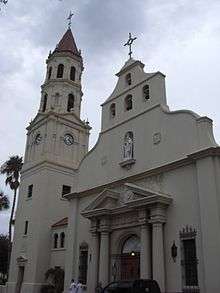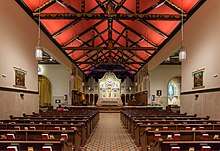Cathedral Basilica of St. Augustine
The Cathedral Basilica of St. Augustine (Spanish: Catedral basílica de San Agustín) is a historic cathedral in St. Augustine, Florida, and the seat of the Catholic Bishop of St. Augustine. It is located at 38 Cathedral Place between Charlotte and St. George Streets. Constructed over five years (1793–1797), it was designated a U.S. National Historic Landmark on April 15, 1970. Its congregation, established in 1565, is the oldest Christian congregation in the contiguous United States.[2][5]
Cathedral Basilica of St. Augustine | |
U.S. National Historic Landmark District Contributing Property | |
  | |
| Location | St. Augustine, Florida, USA |
|---|---|
| Coordinates | 29°53′34″N 81°18′45″W |
| Built | 1793–1797[1][2] |
| Architectural style | Spanish Colonial and Renaissance Revival[1] |
| Part of | St. Augustine Town Plan Historic District (ID70000847) |
| NRHP reference No. | 70000844[3] |
| Significant dates | |
| Added to NRHP | 15 April 1970 |
| Designated NHL | 15 April 1970[4] |
| Designated NHLDCP | 15 April 1970 |
History

During the mid-1560s, the Spanish Empire expanded northward from its Caribbean strongholds, to what is Florida today. St. Augustine was the first colony the Spanish founded on the mainland of what is now the United States that remained continuously occupied. Spanish settlers began immediately to establish a Catholic church. The Roman Catholic Church was integral to the Spanish monarchy and to Spain's history. From the mid-1500s to the mid-1600s, the kingdom was in the midst of a Catholic Revival, in opposition to the Protestant Reformation.
The settlement's church was completed rapidly. Given that the early colonists were mostly sailors or soldiers who had little experience in architecture, the first church of St. Augustine was very simple in design, with a variety of materials and overall hurried confusion about the building of it. The original parish would be short-lived—in 1586, the church burned to the ground in an attack on St. Augustine led by Sir Francis Drake.[6] As they had done two decades previously, the colonists began rebuilding the church and completed it in a matter of months. Once again, the church was constructed hastily using straw and palmetto, which deteriorated quickly in the humid climate. In 1599, a fire destroyed the second church.
Shortly after news of the second church's destruction reached Spain, a tithe was placed for several years; and in 1605, the third attempt was made to construct the church. By this time, more experienced architects and builders from Europe had begun to make their way to the New World, and the third church was built with permanence in mind. It was constructed from timber, and it would stay intact for the next 95 years.
Some years after the timber church had been completed, it began to deteriorate due to lack of maintenance, climatic conditions, and severe fluctuation in the congregation's size. Consequently, in 1702 when the church was again burned down, during a failed English effort to take over the city led by South Carolina colonist James Moore, the church would vanish from the town for over ninety years. There were attempts throughout to rebuild, the most notable in 1707.
The King had sent a large sum of money for the church to be rebuilt, but the funds were never spent on the church as intended—they were spent instead on provisions, back pay for soldiers, and public officials taking a cut (a similar misappropriation of funds had occurred in almost the same manner about a century earlier). During the first half of the 18th century, priests held mass in what was a portion of St. Augustine's hospital. This became a problem as the size of the congregation grew, and was detrimental to its morale as well as to its relations with the Native Americans, many of whom had converted to Catholicism.
From 1763 to 1784, Florida fell under British rule, and concern for reconstruction dwindled. Two years after Spain regained control of the colony in 1784, a new sense of pride arose in the citizenry and a plan for a cathedral was initiated. Construction of the Cathedral of St. Augustine was begun in 1793, as planned. This rendition of the project was the longest-running in the parish's history, and it was finally completed in August 1797.
Architecture

The cathedral's eclectic facade is a combination of Spanish mission and Neoclassical styles. Spanish mission features include curving bell gables, limited fenestration, clay roof tiles, a semicircular tympanum, prominent statuary niche, and comparatively unadorned walls. Neoclassical details surround the entry door; an entablature embellished with triglyphs is topped with a broken pediment above and supported by pairs of Doric columns below.[7]

On April 12, 1887, just as fire had destroyed previous church buildings in St. Augustine, the structure burned once again. The damage was not total, and the exterior shell of the building was still salvageable because the coquina blocks and cement used to build the masonry walls were fireproof. Reconstruction was begun with donations from Henry Flagler and funds raised by the congregation through a national appeal. The congregation hired New York City architect James Renwick, Jr., who happened to be staying in St. Augustine at the time, to restore the burned structure[8] with many improvements being made in its restoration: the structure was enlarged and redesigned with a rectangular-cruciform layout and the addition of a transept to give the church a more European style.[9][10]
As the previous roof truss system was somewhat plain, Renwick devised a system that still relied on timber, but left an exposed ceiling with the decorated and varnished timbers visible. He also added a Spanish Renaissance-style bell tower which was not unique in the US; older Spanish mission churches in the west already had bell towers. The exposed bell had become a symbol of the Spanish mission, and that fact influenced the decision to build a bell tower in the Cathedral of St. Augustine. Four bells were placed in the tower, one of which was salvaged from a previous church and is inscribed with these words in Latin: "Sancte Joseph. Ora Pro Nobis. D 1682.";[11] another of the bells was taken from a British cathedral.

The last rebuilding of the cathedral in the years previous to its 1887–1888 restoration included an innovative idea for building materials. Since susceptibility to damage by fire had proven to be a problem with the wooden structures of the past, the notion arose to use a nonflammable material, and with a modest budget coupled with constraints of transport, a solution was not so clear. In the end, apparently using Native American construction knowledge, coquina stone was used for the exterior walls.[12] Coquina is a sedimentary rock, created primarily from the deposition of seashells on the ancient shorelines. As St. Augustine is a city near the coast, the stone could be quarried and transported with a short distance to travel, and it was easy to quarry because the stone had considerable water content when quarried. After being removed from the ground, the stone hardens when exposed to air, but remains soft enough to be easily worked. This served the exact purpose that was required and was done with minimal effort and cost. The new portions of the building walls added in its reconstruction, however, as well as the bell tower, were made of cast-in-place concrete.[13]
Gallery
 Main Altar
Main Altar
 Side Chapel with mosaic
Side Chapel with mosaic Holy Doors for the Year of Mercy at Cathedral-Basilica of St. Augustine
Holy Doors for the Year of Mercy at Cathedral-Basilica of St. Augustine Catholic Heritage of Florida Plaque in Cathedral-Basilica located in narthex
Catholic Heritage of Florida Plaque in Cathedral-Basilica located in narthex
References
- "Cathedral of St. Augustine". Florida Heritage Tourism Interactive Catalog. Florida's Office of Cultural and Historical Programs. Archived from the original on 10 March 2007. Retrieved 22 Sep 2006.
- "St. Johns County markers". flheritage.com.
- "National Register Information System – Cathedral Basilica of St. Augustine (#70000844)". National Register of Historic Places. National Park Service. 9 July 2010.
- "Cathedral Of St. Augustine". tps.cr.nps.gov/nhl. National Historic Landmarks Program. Archived from the original on 2 May 2009.
- "History of the Cathedral Parish". thefirstparish.org. The Cathedral Parish of St. Augustine. Archived from the original on 13 February 2007.
- Kapitzke, R. (1958). Religion, Power, and Politics in Colonial St. Augustine. Gainesville: University Press of Florida.
- Dewhurst, William (1885). History of St. Augustine, Florida. GP Putnam's Sons.
- "National Register travel itinerary". National Park Service.
- ICMS (1989). A Preliminary Inventory of Spanish Colonial Resources Associated with National Park Service Units and National Historic Landmarks, 1987. United States Committee, International Council on Monuments and Sites, for the U.S. Department of the Interior, National Park Service. p. 71.
- NPS (2020). "Cathedral of St. Augustine: St. Augustine, Florida". www.nps.gov. National Park Service. Archived from the original on July 12, 2019. Retrieved 21 January 2020.
- George Rainsford Fairbanks (1881). History and Antiquities of St. Augustine, Florida. Horace Drew. p. 93.
- Howe, Jeffery (2003). Houses of Worship: An Identification Guide to the History and Styles of American Religious Architecture. PRC Publishing. p. 99.
- The National Register of Historic Places. Department of the Interior, Heritage Conservation and Recreation Service, Office of Archeology and Historic Preservation. 1978. p. 100.
External links
| Wikimedia Commons has media related to Cathedral Basilica of St. Augustine. |
- "Official Cathedral Site"
- "Roman Catholic Diocese of St. Augustine Official Site"
- "St. Johns County listings". flheritage.com. Florida's Office of Cultural and Historical Programs
- Historic American Buildings Survey (HABS) No. FL-15-7, "The Cathedral, St. George & Cathedral Streets, Saint Augustine, St. Johns County, FL", 1 photo, 17 measured drawings, 6 data pages, supplemental material
- HABS No. FL-15-7-A, "The Cathedral Rectory", 2 photos, 1 photo caption page


